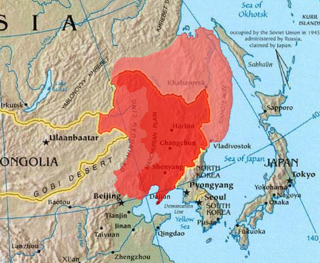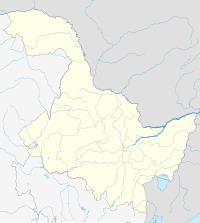
Manchuria is a term that refers to a region in northeast Asia encompassing the entirety of present-day northeast China, and historically parts of the modern-day Russian Far East, often referred to as Outer Manchuria. Its definition may refer to varying geographical extents as follows: in the narrow sense, the area constituted by three Chinese provinces of Heilongjiang, Jilin, and Liaoning but broadly also including the eastern Inner Mongolian prefectures of Hulunbuir, Hinggan, Tongliao, and Chifeng, collectively known as Northeast China; in a broader sense, the area of historical Manchuria includes the aforementioned regions plus the Amur river basin, parts of which were ceded to the Russian Empire by the Manchu-led Qing dynasty during the Amur Annexation of 1858–1860. The parts of Manchuria ceded to Russia are collectively known as Outer Manchuria or Russian Manchuria, which include present-day Amur Oblast, Primorsky Krai, the Jewish Autonomous Oblast, the southern part of Khabarovsk Krai, and the eastern edge of Zabaykalsky Krai.

Khabarovsk Krai is a federal subject of Russia. It is located in the Russian Far East and is administratively part of the Far Eastern Federal District. The administrative centre of the krai is the city of Khabarovsk, which is home to roughly half of the krai's population and the largest city in the Russian Far East. Khabarovsk Krai is the fourth-largest federal subject by area, and had a population of 1,343,869 as of 2010.

Amur Oblast is a federal subject of Russia, located on the banks of the Amur and Zeya rivers in the Russian Far East. The oblast borders Heilongjiang province of the People's Republic of China (PRC) to the south.

A gold rush or gold fever is a discovery of gold—sometimes accompanied by other precious metals and rare-earth minerals—that brings an onrush of miners seeking their fortune. Major gold rushes took place in the 19th century in Australia, Greece, New Zealand, Brazil, Chile, South Africa, the United States, and Canada while smaller gold rushes took place elsewhere.

Manchuria is a region in East Asia. Depending on the definition of its extent, Manchuria can refer either to a region falling entirely within present-day China, or to a larger region today divided between Northeast China and the Russian Far East. To differentiate between the two parts following the latter definition, the Russian part is also known as Outer Manchuria, while the Chinese part is known as Northeast China.

The Treaty of Aigun was an 1858 treaty between the Russian Empire and Yishan, official of the Qing dynasty of China. It established much of the modern border between the Russian Far East and China by ceding much of Manchuria, now known as Northeast China. Negotiations began after China was threatened with war on a second front by Governor-General of the Far East Nikolay Muraviev when China was suppressing the Taiping Rebellion. It reversed the Treaty of Nerchinsk (1689) by transferring the land between the Stanovoy Range and the Amur River from the Qing dynasty to the Russian Empire. Russia received over 600,000 square kilometers (231,660 sq mi) of what became known as Outer Manchuria. While the Qing government initially refused to recognize the validity of the treaty, the Russian gains under the Treaty of Aigun were affirmed as part of the 1860 Sino-Russian Convention of Peking.

The Treaty of Nerchinsk of 1689 was the first treaty between the Tsardom of Russia and the Qing dynasty of China after the defeat of Russia by Qing China at the Siege of Albazin in 1686. The Russians gave up the area north of the Amur River as far as the Stanovoy Range and kept the area between the Argun River and Lake Baikal. This border along the Argun River and Stanovoy Range lasted until the Amur Annexation via the Treaty of Aigun in 1858 and the Convention of Peking in 1860. It opened markets for Russian goods in China, and gave Russians access to Chinese supplies and luxuries.

Outer Manchuria, sometimes called Russian Manchuria, refers to a region in Northeast Asia that is now part of the Russian Far East but historically formed part of Manchuria. While Manchuria now more normatively refers to Northeast China, it originally included areas consisting of Priamurye between the left bank of Amur River and the Stanovoy Range to the north, and Primorskaya which covered the area in the right bank of both Ussuri River and the lower Amur River to the Pacific Coast. The region was ruled by a series of Chinese dynasties and the Mongol Empire, but control of the area was ceded to the Russian Empire by Qing China during the Amur Annexation in the 1858 Treaty of Aigun and 1860 Treaty of Peking, with the terms "Outer Manchuria" and "Russian Manchuria" arising after the Russian annexation.

Blagoveshchensk is a city and the administrative center of Amur Oblast, Russia. It is located at the confluence of the Amur and the Zeya Rivers, opposite to the Chinese city of Heihe. Population: 241,437 (2021 Census); 214,390 (2010 Census); 219,221 (2002 Census); 205,553 (1989 Soviet census).

The Otago gold rush was a gold rush that occurred during the 1860s in Central Otago, New Zealand. This was the country's biggest gold strike, and led to a rapid influx of foreign miners to the area – many of them veterans of other hunts for the precious metal in California and Victoria, Australia. The number of miners reached its maximum of 18,000 in February 1864.

Heihe is a prefecture-level city of northern Heilongjiang province, China, located on the Russian border, on the south bank of the Amur (Heilong) River, across the river from Blagoveshchensk. At the 2020 census, 1,286,401 people lived in the prefecture-level city of whom 223,832 lived in the built-up area made of Aihui District.

Count Nikolay Nikolayevich Muravyov-Amursky was a Russian general, statesman and diplomat, who played a major role in the expansion of the Russian Empire into the Amur River basin and to the shores of the Sea of Japan.

The Sixty-Four Villages East of the River were a group of Manchu, Daur and Han-inhabited villages located on the left (north) bank of the Amur River opposite of Heihe, and on the east bank of Zeya River opposite of Blagoveshchensk. The area totaled 3,600 square kilometers (1,400 sq mi).
Yishan, courtesy name Jingxuan, was a Manchu lesser noble and official of the Qing dynasty. He is best known for his failure to defend Guangzhou (Canton) from British forces during the First Opium War, and for signing the treaties of Kulja and Aigun with the Russian Empire in 1851 and 1858 respectively.

Albazino is a village (selo) in Skovorodinsky District of Amur Oblast, Russia, noted as the site of Albazin (Албазин), the first Russian settlement on the Amur River.

The Sino-Russian border conflicts (1652–1689) were a series of intermittent skirmishes between the Qing dynasty of China, with assistance from the Joseon dynasty of Korea, and the Tsardom of Russia by the Cossacks in which the latter tried and failed to gain the land north of the Amur River with disputes over the Amur region. The hostilities culminated in the Qing siege of the Cossack fort of Albazin in 1686 and resulted in the Treaty of Nerchinsk in 1689 which gave the land to China.

Honghuzi were armed Chinese robbers and bandits who operated in the areas of the eastern Russia-China borderland during the second half of the 19th century and the first half of the 20th century. Their activities extended over southeastern Siberia, the Russian Far East, and Manchuria/Northeast China. The word honghuzi has been variously transliterated as hong huzi, hunhutsi,hong hu zi, hunghutze, hun-hutze, etc. There is also a common transliteration from Russian, khunkhuzy, and a back-formation for the singular, khunkhuz. Korean immigrants to Manchuria in the 20th century called the honghuzi ma-jeok (마적,馬賊). Groups of honghuzi were recruited as guerrillas by the Imperial Japanese Army during the Russo-Japanese War of 1904-1905 into chunchu (チュンチュ) sabotage units.

The territory currently known as Tuva has been occupied by various groups throughout its history. Sources are rare and unclear for most of Tuva's early history. Archeological evidence indicates a Scythian presence possibly as early as the 9th century BC. Tuva was conquered relatively easily by the succession of empires which swept across the region. It was most likely held by various Turkic khanates until 1207. It was then ruled by various Mongol-led regimes until the 18th century, when it submitted to the Manchu-led Qing dynasty. Slow Russian colonization during the 19th century led to progressive annexation of the region to Russia in the 20th century. The region was then controlled by the Russian Empire and the Soviet Union before finally joining the Russian Federation in 1992. Throughout this whole time, the borders of Tuva have seen very little modification.

The Russian invasion of Manchuria or Chinese expedition occurred in the aftermath of the First Sino-Japanese War (1894–1895) when concerns regarding Qing China's defeat by the Empire of Japan, and Japan's brief occupation of Liaodong, caused the Russian Empire to speed up their long held designs for imperial expansion across Eurasia.

The Amur Oblast with the center in Blagoveshchensk was formed on December 20, 1858 by the Personal Decree No. 33862. By this Decree, on the proposal of the Governor–General of Eastern Siberia and the Siberian Committee, the Amur Region was made up of lands "located on the left bank of the Amur River, starting from the junction of the Shilka and Argun Rivers or from the borders of the Trans–Baikal and Yakutsk Oblasts, along the entire course of the Amur, to the mouth of the river Ussuri and to the new border of the Primorsky Oblast".
























